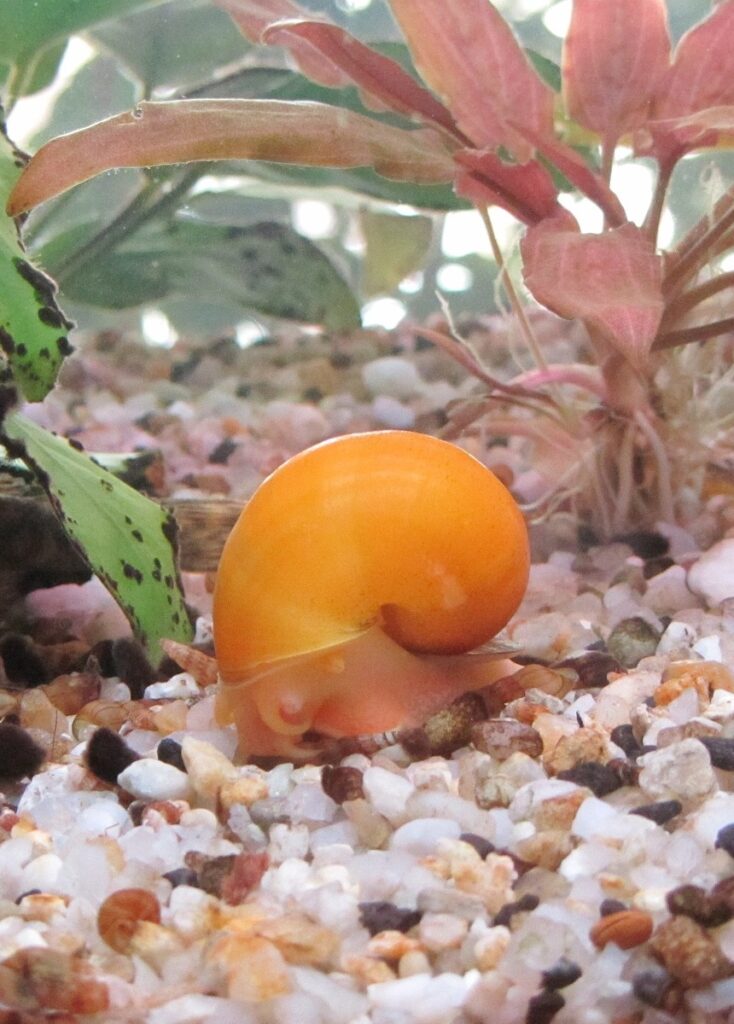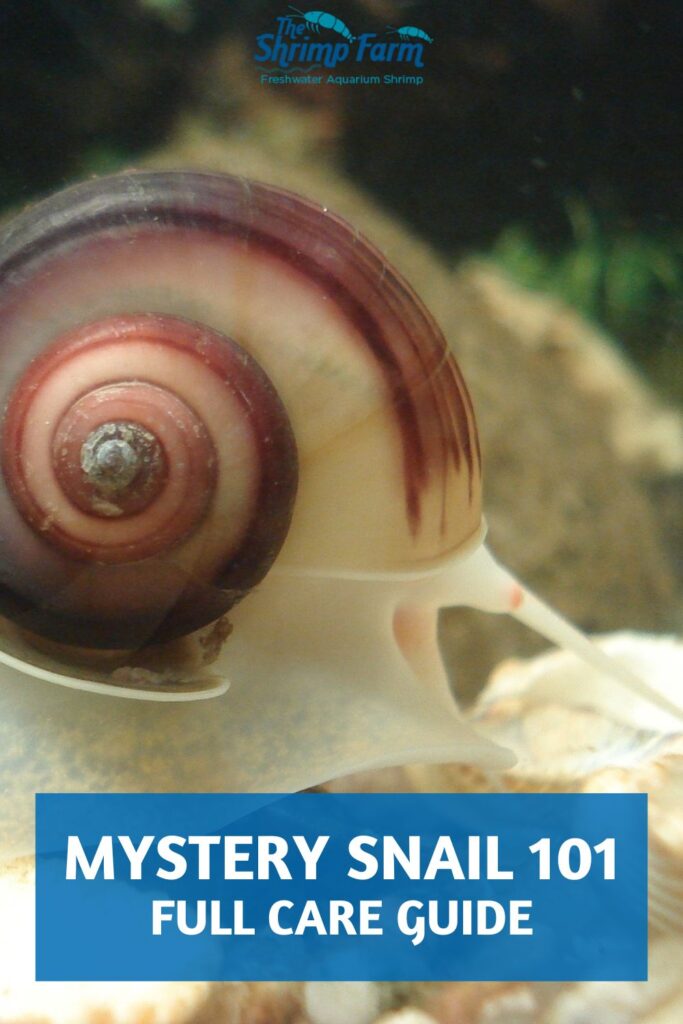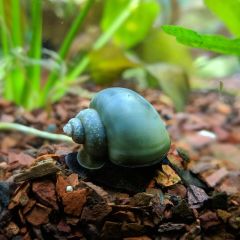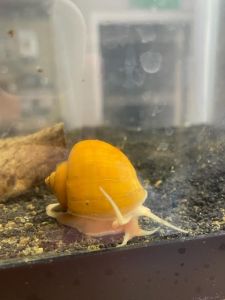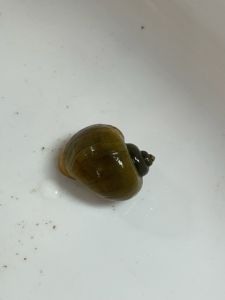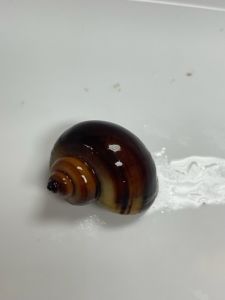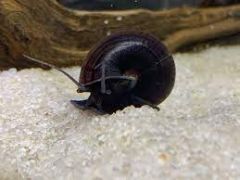Mystery Snail Care 101 | Pomacea diffusa
Looking for a new addition to your aquatic janitor crew? Consider mystery snails! These large, colorful aquatic snails are popular for many reasons: they're fun to watch, active, unfussy, and easy to breed. Plus, they eat leftovers like uneaten foods and dead plant bits, helping to keep your tanks tidy.
Below, find everything you need to know about mystery snails, including where they're from, what they eat, and what kind of aquarium they thrive in.
| Scientific name | Pomacea diffusa |
| Common names | Mystery snail, spike-topped apple snail |
| Difficulty level | Easy |
| Origin | Brazil |
Table of Contents
Mystery snail appearance & natural habitat
Appearance
The first thing you'll notice about mystery snails is how big they get. Most aquarium snails, like nerites, are pretty small—not these guys! They can grow to the size of a golf ball (up to 2.5", in fact), which makes them one of the largest snails available in the hobby.
You can recognize a mystery snail by its rounded, spiral shell, which comes in different colors. Golden yellow is the most common, but as we discuss in the mystery snail color guide, there are actually eight common hues. The snail's body (the "foot") can be yellow or dark brown.
Mystery snails sport long antennae, at the base of which are their eyes. They also have an operculum, the "door" that some snails use to seal themselves inside their shell in case of danger.
Did you know? Spotted a strange appendage sticking out of your mystery snail? Nothing to worry about: it's using its breathing tube, better known as a siphon. Mystery snails have both gills and lungs, a development that helps them survive in low-oxygen waters. Siphon usage may indicate a low water oxygen level in your tank, but it doesn't necessarily—sometimes they just seem to do it for the heck of it.
Taxonomy
If you've been an aquarist for a while, you may have been confused by our calling mystery snails "Pomacea diffusa" rather than Pomacea bridgesii. They were indeed long known under the latter name, but in 2008, scientists published a study noting that:
- The snail species known as Pomacea bridgesii actually contained two species
- The smaller of the two species is the "real" mystery snail
- Mystery snails should never have been called P. bridgesii, they are P. diffusa!
Despite this scientific clarification, mystery snails are still often called by their old name. In this guide, however, we'll use P. diffusa to avoid confusion.
Natural habitat
Due to the confusion surrounding its identity, it's still a little difficult to find information relating exactly where the snail now called Pomacea diffusa is naturally found. However, the study that gave it its current scientific name does mention that it hails from the Amazon Basin, so we can assume it mainly occurs in Brazil.
The IUCN Red List, which classifies this snail as a species of Least Concern (meaning it's not threatened in the wild), mentions that mystery snails inhabits low-oxygen environments like lakes and rivers. Like crayfish, which can be found in similarly dank and often stagnant waters, they've evolved to be able to burrow in the mud as a survival mechanism. This comes in very handy when the water quality becomes too low or their home dries up in the dry season.
By the way, mystery snails are considered to be an invasive species in the USA, particularly in Florida. As an aquarist, it's your responsibility to make sure that your fish and invertebrates don't end up in local waterways. Never release them! They can wreak havoc on our ecosystems.
Setting up a mystery snail aquarium
Requirements
If you'd like to keep one or multiple mystery snail(s), keep in mind their size. As we've mentioned, they grow large. They also produce a lot of poop, which is why we recommend an aquarium volume of at least 10 gallons if you'd like to keep one. Otherwise, you may not be able to keep the water quality high enough.
A good rule of thumb would be 10 gallons for the first mystery snail, and then 2 extra gallons for each additional one (assuming your tank is lightly stocked otherwise). Other than this, you really don't need much to make your snails feel comfortable!
We like to use a thick layer sandy substrate with our mystery snails. There's no risk of it becoming compacted with a few of these guys around, as burrowing is a natural behavior for them.
Did you know? You can keep mystery snails with live plants just fine. Unless they're very hungry, which shouldn't happen in a well-fed aquarium, they only eat dead plant bits. Live plants will be left alone.
Water parameters
Mystery snails aren't too fussy about water quality, although of course, the tank should always be fully cycled. You should perform weekly water changes to keep nitrates down.
What is important is to avoid keeping them in overly soft and/or acidic water. If the pH and TDS values are too low (use a liquid water test kit to check them regularly), you'll eventually notice your mystery snails starting to struggle. In very acidic water, their shells can even begin to dissolve!
Using crushed coral or crushed shells can help keep the water hardness up if your tap water comes out very soft.
pH: 7-8
Temperature: 70-80 °F
TDS: 100-350
Tankmates
Mystery snails are categorically peaceful. They don't attack fish or other invertebrates, ever; if you see one of yours snacking on a dead tankmate, you can safely assume the victim died before the snail started eating it. It's just doing its janitorial duties!
Thanks to their operculum and sturdy shells, these snails are reasonably well-protected. Still, we wouldn't recommend keeping them with aggressive and overly boisterous species, as they'll become withdrawn. Not ideal, because them zooming around and cleaning the tank is half the reason they're so useful and fun to keep!
Peaceful species make for better mystery snail tankmate choices. Try the following:
- Small tetras like neons
- Bottom dwellers such as Corydoras
- Rasboras like the chili rasbora
- Other snails (except assassin snails)
No nippers please! Species like Betta fish tend to like the mystery snail's antennae a little too much.
Mystery snails with shrimp
As for our fellow shrimp enthusiasts, you'll be glad to know that as long as your tank is large enough to accommodate them, mystery snails make excellent shrimp tankmates. They get along great with Neocaridina, Caridina, and other shrimp species. The only exception would be larger Macrobrachiums.
Because mystery snail poop contains a high percentage of partially digested (plant) matter and an abundance of micro-organisms, they can actually be a valuable addition to your shrimp tank as an extra source of healthy shrimp food. Gross, but that's the circle of life!
Mystery snail diet
Now, please pay attention here! As we've discussed, mystery snails are unfussy. However, there is one thing they really need in order to thrive: calcium. It's what their bodies use to grow their shells, and a chronic shortage can lead to a brittle or even broken shell, which can even be fatal. We've already discussed that they need relatively hard water, but they need calcium in their diet too.
Luckily, it's not difficult to ensure your snail gets enough calcium. Your best bet is to feed a special snail food, which contains plenty of it. You can also offer calcium-rich greens like spinach or even special calcium supplements.
Remember that large snails like these do eat quite a bit! We like to leave something edible out for them at all times, even if it's just by not cleaning one of the glass panes so they can snack on algae. Do be sure to remove any uneaten foods after 12 hours to prevent them from affecting the water quality.
Tip: If you're looking for a snail that eats algae, we wouldn't necessarily recommend mystery snails. The superior choice for this particular task, in our opinion, is absolutely the nerite snail.
Breeding mystery snails
One of the reasons so many aquarists keep mystery snails is because they make such fun breeding projects. They breed readily in the aquarium, and if you learn a little about mystery snail genetics, you can produce snails in different colors of your choice.
Some snail breeders even make a little money selling their excess stock! If you'd like to learn to breed your mystery snails, we've got a guide for that: How To Breed Mystery Snails.
Buying mystery snails
Mystery snails are widely beloved among aquarists. Add to that the fact that they reproduce readily in our tanks, and it's no surprise that they're easy to find in most pet and aquarium stores! Golden mystery snails are the most common, although you may also come across other colors.
Looking for specific colors? The Shrimp Farm offers a wide variety of mystery snails in different hues, including surprise packs.
Frequently asked questions
Mystery snails generally live for up to two years. If you keep the water temperature at the higher end of their acceptable range, their lifespans tend to be shorter, as their metabolism will speed up. They'll also breed more quickly, though, so it kind of evens out.
It's not unusual for a mystery snail to stop moving for a few days, usually with a closed operculum. Just pick it up and do the sniff test. If it's dead, trust us: you'll know. There will be no doubt about it.
And by the way, these snails can survive out of the water for a while, so if yours escaped and appears dried out, don't discard it just yet. Put it back in the tank and give it a day or two.
Maybe it's breathing air, or maybe it's just doing it because it can!
Yes, they can. If a floating mystery snail drops back down, it may end up on its back—but that's no problem. You'll notice it returning to an upright position soon enough.
Sources & further reading
Hayes, K. A., Joshi, R. C., Thiengo, S. C., & Cowie, R. H. (2008). Out of South America: multiple origins of non‐native apple snails in Asia. Diversity and distributions, 14(4), 701-712.



 Shrimp
Shrimp Fish
Fish Crab &
Crab & Plants
Plants Foods
Foods Snails
Snails